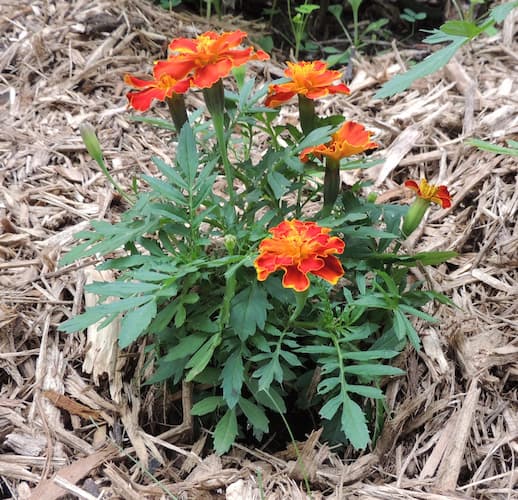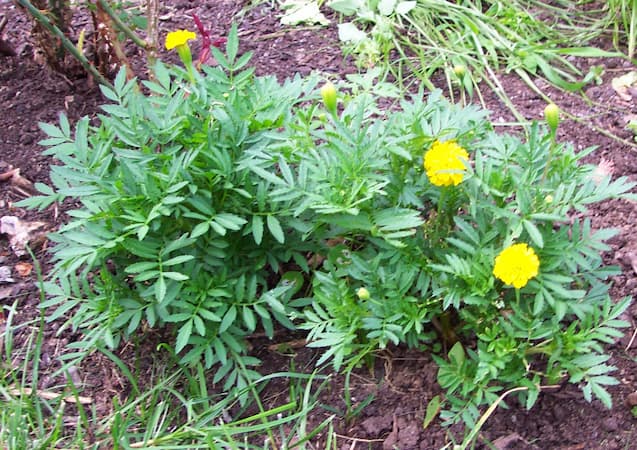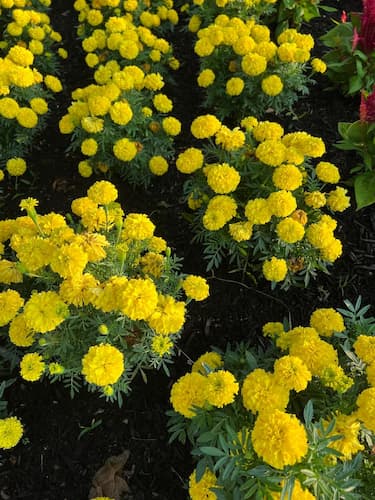How to Grow Marigold Flowers

About Growing Marigold Plants in Your Home Flower Garden
Marigold plants are very prolific, easy-to-grow annual flowers. Kids love ’em and adults love ’em. They are an excellent plant to introduce your kids to gardening. Marigold flowers are available in a variety of colors, including white, yellow, orange, red, and mixed colors. The flowers bloom from mid-summer until frost. They can be used for indoor arrangements. However, they give off a pungent odor that is sometimes too strong indoors.
Annual Marigold varieties abound! There is a variety for everyone and for every need. There is a profusion of colors, multi-colors, and hues. Marigolds also come in a wide range of sizes from miniatures smaller than a foot to giant varieties that can grow up to four feet tall! You can select the color and size that is perfect for your flower garden. And don’t overlook Marigolds in container gardens. The smaller varieties do well in containers.
Marigolds are an easy to grow flower. They make great container plants. Place them in a sunny area of your balcony, patio, or deck so you can enjoy them all day long.
Did you Know? Marigolds are considered companion plants that keep insects away. Many gardeners grow them amidst their vegetable crops. More on Companion Plants

Marigold Plant Specifications
Flower Colors: Gold, orange, red, white, yellow, and many bicolor varieties.
Flowers Bloom: Summer through Fall.
Plant Height: Six to thirty inches tall, depending upon variety.
Ideal Soil pH: 5.5 – 7.0.
Light Requirement: Full sun.
Hardiness Zones: 2 – 11
Are Plants Toxic? Some yes, Some no.
Deer Resistant? Yes. It is deer and rabbit resistant.
Number of Species: 50 species worldwide.
Native To: Central and southern North America.
Plant Type: Annual
Botanical Name: Tagetas Ercta, Tagetas Patula
Popular Varieties: Crackerjack, Petite Yellow, Queen Sophia
Are Marigolds Edible?
Some yes. Some no.
French marigolds are edible.
We strongly recommend you do not consume marigolds unless you are positively certain they are French marigolds. African marigolds are not edible. They have a strong flavor and can cause stomach discomfort.
Medicinal Uses for Marigolds
Marigold plants have a number of medicinal uses. Among them are:
- Make an ointment from them to ease skin irritations.
- It eases the pain of sunburn and other light burns,
- Marigolds detoxifies the liver.
- It boosts the immune system.
- Use it to lower fevers.
Light Requirements
Annual Marigold plants grow best in full sunlight. Plant them in a location where they receive six to eight hours or more of bright, direct sunshine.
The plants tolerate a little light shade, especially in the hot afternoon hours. However, too much shade results in leggy plants and fewer blooms.
Annual Marigold Flower Plant Propagation
Marigolds are grown from seeds. They sprout quickly. Marigold seeds can be directly sowed into your flower garden or seeded indoors for transplanting later. We recommend planting Marigolds in pots and containers indoors, then transplanting them outdoors. This allows you to make the proper spacing without the need for thinning seedlings.
Sow Marigold seeds early in the season and cover lightly with soil. Water thoroughly once. They germinate easily and will grow quickly, producing their first of a continual display of blooms by mid-summer.
Transplant Marigold plants into your garden after the last frost date for your area. Spacing depends upon size with miniature varieties spaced four to six inches apart, and Giant varieties one to two feet apart.
Final Plant Spacing: Plant smaller varieties 12 inches apart. Space larger varieties 18 inches apart.
Days to Germination: 5 – 10 days.

How to Grow Marigold Flower Plants
The plants like full to partial sun. However, they tolerate light, partial shade.
Marigold plants like rich, well-drained soil, but are very tolerant of average to slightly poor soils. Improving your soil quality will produce much healthier plants and flowers, so add plenty of compost. Add a general-purpose fertilizer once a month.
Once your Marigolds are established, they should grow well, even if left unattended. Soil should be moist, but not wet. Water them during dry periods, once or twice per week.
Add mulch around the plants for appearance and to keep weeds down.
Around mid-summer, your plants will begin to produce flowers and will continue to do so up to the first frost. You do not need to remove dead flower blooms, except for appearance.
Marigolds are annual and susceptible to frost. They may survive the first light frost with only a little damage. They will not survive a hard frost or freeze.
Saving Seeds: Marigold seeds are easy to harvest for next year’s gardening season. Wait until the flower turns brown and has completely dried. Next, pull the seeds from the pod. Then, allow the seed to dry for several more days. Finally, store them in a paper envelope in a cool, dry place. More on Storing and Saving Seeds.
Growing Marigold Flowers in Containers and Flowerpots
If you are looking for a bright, cheerful, easy to grow flower for your patio or deck, marigolds are the answer. They look great in all sizes of containers, flowerpots and window boxes. And, the plants tolerate a little crowding.
In addition to the normal steps for growing them, here’s how to care for them in a flowerpot:
- It is important to have a drain hole to allow excess water to drain from the pot.
- Keep an eye on the moisture level. Check the plants every day or two, especially in extended periods of hot, dry weather.
- Keep the soil moist, but not wet. It is okay to let the top of the soil begin to dry between watering.
- When watering the plants, thoroughly wet the soil. Excess water will drain through the hole in the bottom of the flowerpot.
- Nutrients in a flowerpot are limited. So, use fertilizer spikes to feed the plants. Or, apply a light solution of liquid fertilizer once a month.
- Select a sunny to partly sunny location on your deck.
Insects and Plant Disease
Insects largely avoid Marigold plants. They do not like its pungent odor. This is why Marigolds make good companion plants. You can even make an insect repellent spray from these plants. See Organic Sprays
While insects avoid Marigolds, slugs can do major damage. Slugs like to slither up the stem and chew on the leaves. They can destroy an entire flower garden of Marigolds. They can be seen on the plants overnight, in wet weather, and early morning. If an infestation occurs, treat quickly to avoid major damage. More on Slugs and Snails
Also see: Plant Problems – Identify the causes and find the cures.
How to Prune Marigold Plants
The plants are almost maintenance free. Pruning is not necessary. However, you may want to remove the occasional damaged or broken stems and leaves.
Deadheading spent blooms is not required, either. However, you may want to remove them to improve plant appearance. If you leave them on the plant, you can harvest seeds for next year’s crop.
Related Articles
Also, people who read this article will like:
How to Grow Marigold Plants – By Garden Hobbies
Please support our site. Shop for:
- rmmatthews100@hotmail.com
- 585-721-6528
- Rochester, NY
©1999-2024 GardenersNet.Com, All Rights Reserved

